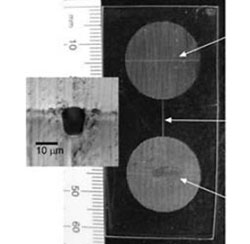First synthetic tree
In Cornell University's laboratory, for the first time in the world, the team of Abraham Stroock and Tobias Wheeler created a synthetic plant that simulates the water transport of conductors in plants. The work has just been introduced in Nature.

A 1mm thick pHEMA plate with 80 channels of different lengths is arranged to form a circle and linked by only one channel.
Called a synthetic tree, it doesn't look like a natural tree. It consists of two rings placed side by side in a transparent and flexible hydrogel piece (used in contact lenses). In the two rings, there are fluid channels that are evenly spaced to mimic vascular bundles in the trunk.
In nature, the tissue in the trunk is tubular, called a vein, which is responsible for drawing water from the ground and transporting it to the leaves. In synthetic plants, the conductors are made of pHEMA hydrogel, a material with many nano holes and act as a membrane layer by holding the liquid in the holes, making the water move in the conductor under negative pressure, in a super stable liquid state - the state just before vaporization.
The work of synthetic plants has contributed to prove the process of transporting water in the trunk is a pure physical phenomenon, does not require bioenergy. Integrated circuit operation can also be used as new cooling methods for cars, homes or even laptops, building better soil regeneration and drainage systems .
- Artificial plants are called to grow all over the United States
- The oldest tree in England has changed sex after 3,000 years
- Ancient trees have unique and strange shapes all over the world
- Mysterious fir tree regenerates itself from the dead
- He deciphered the ash tree sequence
- Story about 'devil tree': Witness the massacre of 1 family and many other deaths
- In America there is an oak tree
- The 10 most exotic plants on Earth
- Does synthetic biology protect wild life?
- The oldest 9550-year-old tree from the Ice Age
- Why is there a tradition of decorating and lighting up Christmas trees?
- Highest tree species - Almond Tree Eucalyptus amygdalina
 Why do potatoes have eyes?
Why do potatoes have eyes? 'Tragedy' the world's largest carnivorous life: Death becomes ... public toilet
'Tragedy' the world's largest carnivorous life: Death becomes ... public toilet Tomatoes were once considered 'poisonous' for 200 years
Tomatoes were once considered 'poisonous' for 200 years Detecting microscopic parasites on human face
Detecting microscopic parasites on human face